Last updated: April 7, 2025
Article
The Cultural Landscapes of Georgia O’Keefe
National Center for Preservation Technology and Training
This presentation, transcript, and video are of the Texas Cultural Landscape Symposium, February 23-26, 2020, Waco, TX. Watch a non-audio described version of this presentation on YouTube.
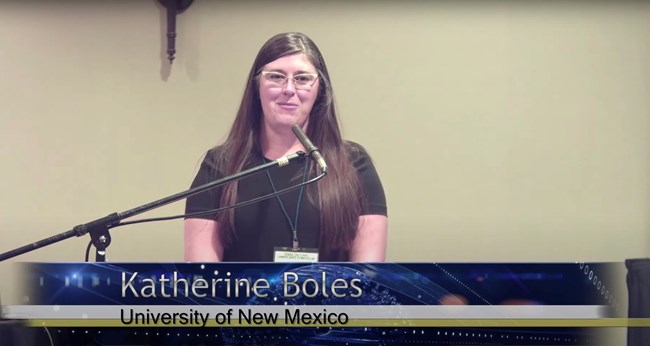
National Park Service
Katherine Boles: Hello everyone. Thank you very much, Debbie. And I'm really excited to be here. I really enjoyed learning from all the wonderful experts that are here so far in the conference and I'm excited to share a little bit about my ongoing work as the 2019-2020 Georgia O'Keeffe Museum Cultural Landscape fellow and it will come up soon. Yes. Okay.
In this photo here, this is a view from Georgia O'Keeffe's Abiquiú property looking North and you can see the Rio Chama delineated by the cottonwoods in the fall, and this view is part of an important view shed from her property and it's specifically from her studio, her painting studio and also from her bedroom and you can see it also from the driveway.
This project that I'm working on is part of a three-year project that was a partnership between the University of New Mexico (UNM) School of Architecture and Planning, Historic Preservation and Regionalism program and the Georgia O'Keeffe Museum and the National Park Service, National Historic Landmark program. Thank you Skylar [Bauer] and Astrid [Liverman]. They're going to be presenting after me and part of the funding is coming from the NHL program, the other funding is coming directly from the Georgia O'Keeffe Museum and that's just the funding for this one year of the project.
This is a three-year project and the product would be, hopefully, a series of cultural landscape studies to guide the museum's management of the properties. In year one, we're focusing on the Abiquiú property and in the following years it will follow the same format, but we'd focus on someone else, a different fellow, would focus on the Ghost Ranch Property and then the larger Northern New Mexico areas that were important influences for O'Keeffe's artwork and lifestyle.
In year one, we started in the Summer of 2019 in August with a one-week summer class taught by my supervisor for the project, Julie McGilvery. Thank you, Julie and Francisco Uviña, he's with the UNM HPR program. And then after the Summer class, which was for multidisciplinary and undergrad and graduate students, one-week intensive fieldwork-based summer class. After that, I was selected as the fellow, following the academic year, the 2019-2020 academic year working on this one property.

Katherine Boles, University of New Mexico
Looking at each of the years in a little bit more detail here. This is the Abiquiú property. O'Keeffe's property is right here and it's basically a new design building that's a combination of modern and vernacular building traditions and it's partially reusing a former Spanish colonial courtyard house ruin as the footprint and some of the material actually as well and it sits on a steep slope right here bounded by two arroyos, which are dissolve ways for a larger acequia irrigation system near Abiquiú Plaza coming from a creek up high. The slope overlooks Rio Chama Farmland that is a acequia irrigated off of the Rio Chama. And in addition to the house being a ruin before O'Keeffe purchased the property, there was a garden right here that existed on the site as well and that was one of the reasons that O'Keeffe was really interested in purchasing this property. And when we go to the next slide, you can see why because this is the property that she owned, this is the Ghost Ranch Property. She owned this before the Abiquiú property and it's in a very remote and dry area where there is no acequia irrigation system and no garden, no opportunity to have a garden here. She had her food brought in. And with the increased pressure, her own preference and also the increased pressure of war rationing led to a desire to have another property and then purchasing the Abiquiú property within five years of purchasing this property and they're very, very close to each other as we'll see on this next slide.
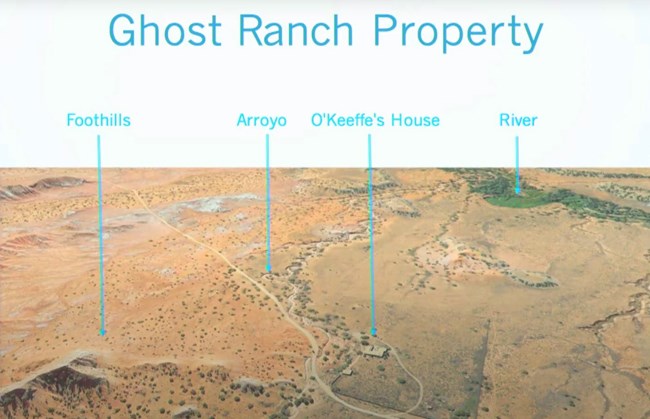
Katherine Boles, University of New Mexico
There is Abiquiú, there's Ghost Ranch. Very close. Yes. This would be the topics for the third year, potentially, looking at maybe two sites, the white place and the black place that O'Keeffe had lots of paintings of, as well as in addition to the two places that she lived for the majority of her of her time in New Mexico. Also in Santa Fe where she lived for the last two years of her life and purchased another property there and Taos where she came in 1929, I think that's the right year, yes. And stayed with Mabel Dodge Luhan there. And these are just places within Northern New Mexico. There is many more cultural landscapes of O'Keeffe's entire life that could be studied. She lived in quite a few different places, but this is just within New Mexico.
UNMs pedagogical goals could really be satisfied looking at a number of landscapes in New Mexico, there's definitely lots of wonderful places to study. However, maybe like why are we looking at Georgia O'Keeffe's properties and this is kind of like a happy marriage of circumstance to a degree. There's practical things like timing and the museum's demonstrated need for needing cultural landscape studies. They have ongoing HSR projects and conservation reports so this really fits in well with their current studies of the property and would help augment that and is really needed.
There's also funding that's available that's very helpful as well and the fact that there's multiple properties so it can be studied with over a series of years and looking at a much larger, they kind of combined to form a larger landscape. And also the Abiquiú property itself is a national historic landmark due to its high integrity and its association with O'Keeffe . O'Keeffe is really important for the critical role in development of American modernism and the fact that she was a woman artist in a time when there were very few well known women artists and she's also become an American icon and mythic figure.

Katherine Boles, University of New Mexico
Those three reasons, in addition to the fact that O'Keeffe was very connected to the land and the landscape was very inspirational to her artwork and her personal life. As you can see in this, this top image is one of O'Keeffe's paintings and this bottom image is a photo that I took on the site. This is a very similar view standing in a similar location that the first initial slide was taken but looking off to a little bit to the east and you can see that even though the painting is considered abstract, there's definitely elements of realism with like the profile of the mountains and all this and all this other stuff as well. This is a similar view to what she could have seen out of her bedroom window.
Year one, like I said, we started with the one-week summer class and the fellowship has really broken down into two different parts. Last fall I was looking at doing a lot of historic research and field research, like archival research and field research and then now in the spring I am grappling with trying to write this all up in a report and coming up with treatment recommendations, which I'm sure Julie will be very, very helpful with. And then I will turn in a draft form in May and Julie will help finalize it and it will be due in August.
This is a picture of the summer class, a bunch of us students, it was really exciting because we got to take the cover off of the old well and look down there and you could see the water table in which direction the water was flowing and how deep it was and this was matching up with different descriptions of the well from when [Maria] Chabot was looking at the property and O'Keeffe was looking at the property so it was pretty neat to see that on the site.
I'm going to talk about the research process that I really use so far in documenting this property or trying to document this property and I'll walk through these steps. This is a recent aerial photo so it's looking straight down Google. There is the main house and there's the studio building. North is up on this. The previous, the first image was taken like from here looking out so the Rio is over there and then that second artwork image was taken kind of looking that way at a little Mesa over there. There are two arroyos on either side of the property and then a few other key things to point out; there's a really steep slope here, a bomb shelter that she added to the property. This is a mainly cactus area that's managed just to kind of keep the cactus down. There's an old corral here and pig pen that used to be that; this used to be a barn that's now the studio. This is a motor court driveway, main vegetable garden over here, orchard terrace area and service road.
When looking at this project it's where to start and we'll try to start at the beginning looking at cultural and physical history of the larger region and this area has a really long and rich history, as we all know, well before O'Keeffe. In particular in 1754 there's was Spanish colonial land grant of Santo Tomás de Abiquiú to the [inaudible] which are detribalized native Americans and before that the site was occupied on and off by American Indians since at least 9,000 BC. Of note, we think that the original house on the site may have dated to 1744, which is 10 years the actual land grant took place.
How to study all this. That was a little tricky and it came down to really good collaboration with other experts, specifically local historians and archeologists making use of really good tools like the Web Soil Survey and historic aerial images and things like that. The conservation team installed a weather station on the site and is collecting climate data. Just as a little side note with the aerial vegetation, when I was doing my MLA, I worked for a PhD student who was trying to survey the vegetation in the Arctic over really large areas, so he used high resolution aerial imagery and had a whole grid of data points in GIS, and my job was to go and spend hours IDing plant species at every single grid point and this high resolution aerial image. It's actually, it's really interesting what you can do with just IDing stuff off of aerials. Although the ones we're using for this project are a little blurry, unfortunately.
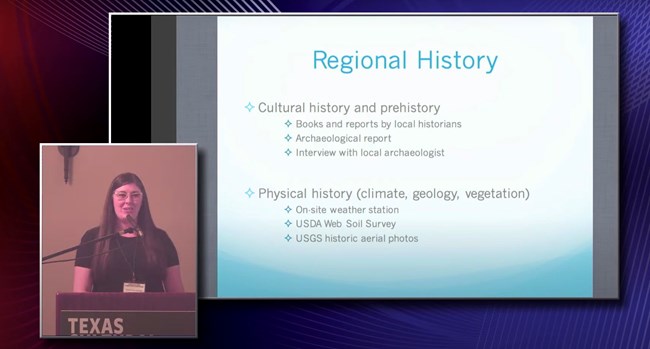
Katherine Boles, University of New Mexico
A great thing was as I mentioned, working with a local archeologist, I got to talk with him kind of like an informal interview and that saved me a ton of time and it was fascinating, because he actually gave me a whole list of books and journal articles and resources to just go read. He'd already done all the research and just said, "Look at all this stuff." He also pointed out sources that were incredibly difficult to find. I probably never would have found them on my own. It was from like a public library in Minnesota and it had no label associating it with O'Keeffe. It was mislabeled there were images. It's kind of amazing what can be found with the partnerships that you can make. He also told me about really good other people to interview and work with. That was really helpful.
Also, for this particular project, we're looking at geologic time. Going back and this is important because of Georgia O'Keeffe's artwork, you'll see layers of rock and they're different colors and you see the strata and that kind of stuff so it's kind of interesting to make those pairings between an artist perspective and then this large geologic time reference, as you can see here. This is the White Place, which is one of the places that O'Keeffe like to paint and it's actually just north of the property just across the river there and it's made out of volcanic ash, tufa, different ways to say it so has these really unique forms.
In addition to looking at the regional context, it's really important to look at prior studies that have already been done on the site. One thing that's important is since this is a national historic landmark with association to Georgia O'Keeffe, is learning about Georgia O'Keeffe and there's tons and tons of material out there so I look to the museum staff to help point me to the best resources. Again, making use of a network of connections to try to target, hone in on things that'll actually be helpful.
A great deal of research has already been done about this property and is currently ongoing with the property as well, as you can see here. There's a NHL nomination, there's HABS, there's two HSRs, structural analysis report, geo-tech boundary and topo surveys, thank goodness and there's concurrent studies including another HSR. There's an architectural conservation report. There are other fellows that are studying various topics including like bones and rocks and cool stuff, and there's also this internship program that the museum has started that deals with growing vegetables in O'Keeffe's garden.
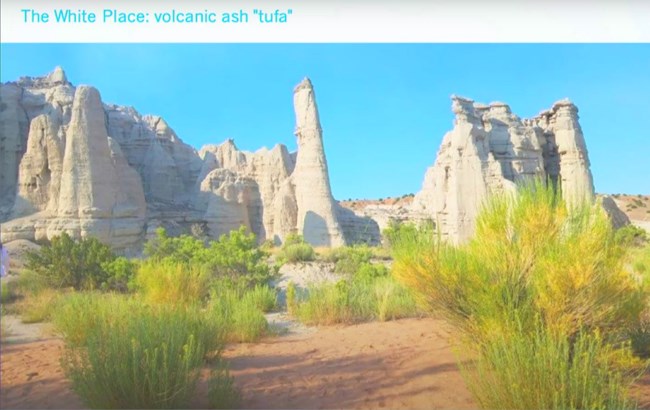
Katherine Boles, University of New Mexico
In addition to that, the museum has the original research materials from the National Historic Landmark nomination and a bunch of material when they were doing deed research. Lots of material on that, the primary sources in their archives. Because the cultural landscape studies exist with a prior, concurrent and future reports and they are living documents, it's really important to have strategies to compile and organize all of this research, especially research that's going on concurrent with current studies. I think maybe you all know, you would know way better than me if there's like a really great tool online platform for researchers to share in real time with each other to update, it's like Airtable or Google Docs, something like that but I was thinking like specifically for chronologies and for like a database of primary source quotes that would only be used internally but everybody can keep adding to it and the museum can keep it. Stuff like that came up during this project, that'd be useful to have for us specifically.
This is looking at one of the projects as currently ongoing. The house is adobe but it was stuccoed over with cementitious stucco, it was O'Keeffe's decision to do that during her lifetime. It currently has cementitious stucco; however, it's been an ongoing question about whether to take it off or not and so a portion of that was removed in 2014 by the museum and re-plastered with mud. However, it proved much too difficult for them to maintain with their current maintenance staff and so that's why there's this plastic over it because it's protecting the adobes from further deterioration and it will be re-stuccoed over with cementitious stucco.
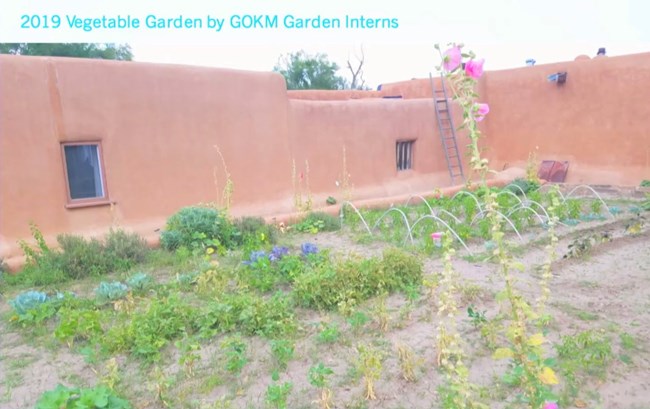
Katherine Boles, University of New Mexico
Another example of changes that are currently ongoing on the property. This is the vegetable garden from last summer that the internship program planted and took care of and harvested and cooked a wonderful meal from but it's different every year. While it's still a vegetable garden in the same location that O'Keeffe had her vegetable garden, it's still very different. It's interesting how to document that change in practices.
After you've looked at the regional context and prior research, you can finally start on this site specific, archival research, and this is something that I wish I had started earlier in the project. I spent a little bit too much time on the regional context because it's fascinating and really complex but there's a ton of archival material for this particular project. For most people that have a ton of, I'm sure most people in the audience have a ton of research experience and this is maybe not helpful. If there's anyone out there that's just starting, these are some potential resources that might be helpful.
And then for this project, I was really fortunate that the Georgia O'Keeffe Museum Research Center S. Engl Family Foundation Library and Archive has a really large archival collection. Specifically what was really helpful was correspondence, so I spent a lot of time reading the actual letters that Georgia O'Keeffe wrote to others and that other people wrote to her, which then you get in her own words or other's words, different quotes in the particular time period about potentially the garden or the property. There was quite a bit of discussion about design decisions during construction and some information about O'Keeffe's continued alterations to the property. Historic aerials and photographs were really helpful. If they're too dark or too light, I could alter them in Photoshop to try to make things a little bit more legible. That was a helpful tool.
However, not all of the archival material exists just at the museum resource center. There's actually quite a bit at the Yale Beinecke Rare Book & Manuscript Collection, as Claire knows. Some of that is sealed and therefore inaccessible for a certain amount of time after death. Each one is sealed for a different period of time so that makes it a little bit tricky and then also the museum is still actively accessioning materials to their collection, some of which were added during the scope of this project, so you just have to kind of be aware of that and keep looking for things. The staff was great about telling me when new things were coming in and letting me see them and that kind of stuff and trying to help me work through when finding aids weren't really available.
One of the main difficulties was reviewing a large quantity material in a short period of time. I'm sure everyone has different tools. Like I talked about was asking different people who are knowledgeable and getting targeted answers and then you know if it's digitized, being able to do like a keyword search, learning how to skim and when I was reading the letters I was finding there was like patterns in the way different people would write about things. You might find they're talking about, if they're talking about their family, the garden is not really going to be in that paragraph so you can kind of skip through it and then just look for a garden topics or something like that.

Katherine Boles, University of New Mexico
It's really important to go back and forth between archival research and field research and it really is back and forth. You can't just do one first and then go to the other one. For this project, an example of that is, so this is the studio building. This is facing north and north is this way. That's her bedroom and the studio. This is the bomb shelter here, overgrown by cactus and there's actually, what you're not seeing is a path and steps underneath here, which I was made aware of when I saw a 1979 aerial photograph. You could see the path and you could see the steps on that. It keyed me into, hey, there's something here I should probably go look at that. Another example where these flagstone paths, which again looking at that same aerial helped me find them and then I went there and kind of dug in the dirt and moved the leaves around and was able to find them.
It's really helpful to have a survey and unfortunately a lot of the information that's currently surveyed, it doesn't include everything that we want to include so here's a list of the features that I added by hand using a tape measure and also using a Trimble sub-meter GPS unit and this is just a screenshot showing my CAD file where I keep all the information.
It brought the survey in. I geo referenced an aerial photograph that was actually taken from an airplane so it was definitely, it was on an angle. It's kind of tricky to … it's not a perfect geo-reference but I just wanted to get it enough to be able to underlay it and then I traced different features from the aerial, the blue are tree spreads that I traced from underlaying the 1996 HABS drawing and I'm comparing that to the green, which is all of the tree spreads that I measured by hand. Some of the really interesting things that aren't on the survey or the trash cans were O'Keeffe burned her paintings that she didn't want. There are gravestones from where she buried her dogs and she had rock collection displays on tree stumps and things like that around the landscape. Also found again on the aerial, an area of a squash patch that didn't know about before, showed places where firewood was stored and a lot of other interesting uses of the landscape.
Really, really important was discussion with the site managers. I can't really express how important this is for me on this project. As Abiquiú property has been continuously cared for in part by members from one of the local families and shortly after O'Keeffe brought the property in 1945, their accumulated knowledge creates a rich and invaluable legacy of management traditions. There's three siblings that work directly for O'Keeffe during her lifetime to care for the property and they currently care for the property. Their mother was her cook, one of her cooks and their grandfather was her gardener and they really intimately know this property and have a lot of stories about life with O'Keeffe.
Like one of them helped her paint when she was losing her eyesight and would burn her paintings that she didn't want. One of them cares for the landscape and knows he can walk around and say for every single thing that was planted, when it was planted and how it's been cared for, if it was replaced, where it was replaced from, where he got the material from, all that information. It's really great and what I'm showing here in this photo is a practice of management in the Fall where they burned some of the vegetation and that's something I never would have known about if I hadn't talked to them. My strategy for that, I really liked them. They're wonderful people and there was a formal oral history done but this was just really informal and just kind of hanging out and talking and learning and just listening what they felt was important to share about the landscape and letting that kind of guide the conversation.
And the next steps are basically formalizing the report, like I mentioned before, proposing treatment and then organizing all this material for whoever comes next. Okay. Any questions?
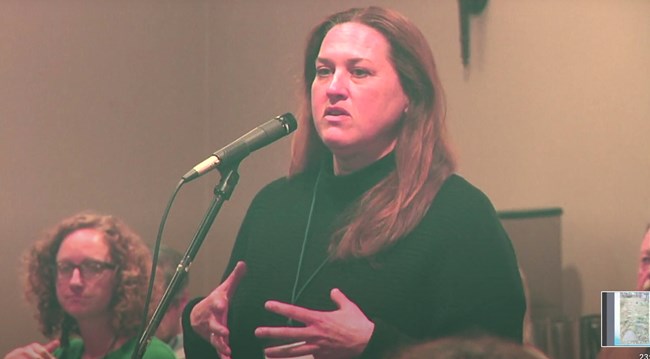
National Park Service
Speaker 1: Really great introduction.
Katherine Boles: I have a very odd multidisciplinary history, which I've cultivated over a long time because those were my interests really lie in architectural landscape, architecture, ecology and historic preservation and when I was working for an architecture firm, I got to work on several HSRs in Santa Fe and then I got to take the summer class while I'm at UNM because I've had my eyes opened, historic preservation kind of looking for cool opportunities and through that was exposed to this opportunity with a great support from Julie.
Speaker 2: To what extent are Georgia O'Keeffe's paintings themselves important in prioritizing viewsheds and vistas?
Katherine Boles: Incredibly important. Yes. And that it will be part of the project. That work has already been done to a degree and the paintings are all cataloged in a book and so we will match up different ones for the property. Yes.
Susan Dolan: Say something about the objectives that the museum [inaudible] has with the treatment plan.
Katherine Boles: I think this would, and Julie might help me speak to this a little bit, I don't know, but although there's been a lot of studies on the building itself, this is really to my knowledge, the first study looking at the entire property, a complex study looking at it and I think anything we can give them will be helpful. Julie, do you want to take on the treatment one?
Julie McGilvrey: I visited with the staff of the museum and this was probably three years ago now, and they discussed their projects in the future and then they said we have all these issues with a landscape and we don't know anything about its evolution except they know tons about its evolution but it's not put together, and so that was the conversation we had. I was like a believer, you actually know what's happened here and you know what's here, but things were all in all these different spots. So I viewed it as an organizational effort and then the treatment is a big discussion because we're having some issues between conservation recommendations from the conservation plan, the HSR to the cultural landscapes so since all of that's happening all at once, now we're having a dialogue and there's lots of things that keep popping up that are in a little bit of conflict with each other but we can work through it.
Everything's kind of coming together nicely for this house I think but yeah, they know a great deal. It's just they didn't know about cultural landscapes. It goes back to that and when we had the discussion of what a cultural landscape is, then they were like, we want to do that and they have all the information. Yeah. Kate's been wonderful talking with them and putting that together and making all that really work. Yeah. Thanks.
Speaker 3: You’ve got a whole lot of interpretive possibilities there that you've got nuance stuff in a landscape and the artist herself was very nuance. Are you planning on using this not just for treating the property but for interpreting her life there?
Katherine Boles: Yeah, I can't speak for the museum on that, but I do know that they have a whole team that focuses on interpretation and I do believe that would be a really important part of this project. They are always coming up with new interpretive objectives and hopefully this report would be, I could see it as being incredibly valuable for that. Thank you very much.
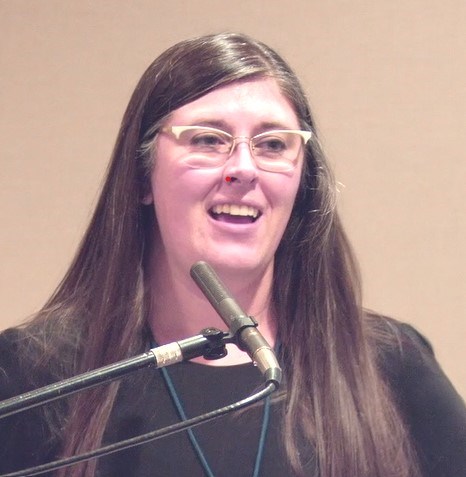
National Park Service
Speaker Biography
Katherine Boles, ASLA, received her B.S/ in Ecology and Evolutionary Biology and BA in Biochemistry and Cell Biology from Rice University and Masters in Landscape Architecture and Certificate in Historic Preservation from the University of Virginia. She is currently a graduate student in the Masters of Architecture program at the University of New Mexico and is the current Georgia O’Keeffe Museum Cultural Landscapes Fellow.
